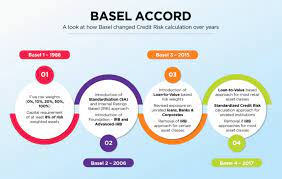The Basel Accords are a set of international regulatory standards that provide guidelines and recommendations for risk management and prudential supervision of banks and financial institutions. They are developed by the Basel Committee on Banking Supervision (BCBS), which is a global forum consisting of central banks and bank supervisory authorities from different countries. The Basel Accords aim to promote financial stability, enhance risk management practices, and ensure the adequacy of capital and liquidity in the banking sector. There have been three major iterations of the Basel Accords: Basel I, Basel II, and Basel III. Here’s an overview of each:
- Basel I:
- Basel I was introduced in 1988 and focused primarily on credit risk. It established the minimum capital requirement for banks based on the risk weightings of their assets. Under Basel I, banks were required to maintain a minimum capital adequacy ratio (CAR) of 8%, with a minimum of 4% in Tier 1 capital.
- The risk weights assigned to different asset classes were relatively simplistic and did not fully capture the risk variability within those classes. For example, all corporate loans were assigned a risk weight of 100%, regardless of their credit quality, and there was no explicit consideration of other types of risks such as market risk or operational risk.
- Basel II:
- Basel II, introduced in 2004, aimed to address the limitations of Basel I and provide a more comprehensive framework for risk management. It introduced three pillars:
a. Pillar 1: Minimum Capital Requirements – Basel II expanded the risk-weighted approach in Basel I by introducing more risk-sensitive methodologies for credit risk, market risk, and operational risk. It allowed banks to use internal models for risk measurement, subject to regulatory approval.
b. Pillar 2: Supervisory Review Process – Basel II emphasized the importance of banks’ internal capital assessment and risk management processes. It required banks to conduct their own assessments of capital adequacy and to undergo a supervisory review by regulators.
c. Pillar 3: Market Discipline – Basel II introduced enhanced disclosure requirements, aiming to promote market discipline and transparency by requiring banks to disclose information about their risk profile, capital adequacy, and risk management practices.
- Basel II, introduced in 2004, aimed to address the limitations of Basel I and provide a more comprehensive framework for risk management. It introduced three pillars:
- Basel III:
- Basel III, developed in response to the global financial crisis of 2008, introduced more stringent capital and liquidity requirements to strengthen the resilience of banks and mitigate systemic risks. It consists of several key components:
a. Capital Requirements: Basel III increased the minimum capital requirements and introduced a new definition of regulatory capital. It introduced a Common Equity Tier 1 (CET1) capital requirement of at least 4.5% of risk-weighted assets (RWA), a Tier 1 capital requirement of at least 6% of RWA, and a Total Capital Requirement of at least 8% of RWA.
b. Capital Conservation Buffer: Basel III introduced a capital conservation buffer of 2.5% of RWA, which banks are required to maintain in addition to the minimum capital requirements. The buffer is designed to withstand periods of stress and can be used to absorb losses.
c. Liquidity Requirements: Basel III introduced new liquidity standards, including the Liquidity Coverage Ratio (LCR) and the Net Stable Funding Ratio (NSFR). The LCR requires banks to hold a minimum level of high-quality liquid assets to meet their short-term liquidity needs, while the NSFR establishes a stable funding requirement to ensure banks have sufficient longer-term funding.
d. Counterparty Credit Risk: Basel III introduced measures to address counterparty credit risk, including the introduction of the Credit Valuation Adjustment (CVA) capital charge and the requirement to use central clearing for certain derivative transactions.
e. Leverage Ratio: Basel III introduced a non-risk-based leverage ratio, which sets a minimum capital requirement based on a bank’s total exposure without considering risk weights. This measure aims to limit excessive leverage in the banking system.
- Basel III, developed in response to the global financial crisis of 2008, introduced more stringent capital and liquidity requirements to strengthen the resilience of banks and mitigate systemic risks. It consists of several key components:
The Basel Accords, particularly Basel II and Basel III, have had a significant impact on risk management practices in banks and financial markets worldwide. They have prompted banks to develop more sophisticated risk management frameworks, improve risk measurement and modeling techniques, enhance capital and liquidity management, and strengthen risk governance and disclosure practices. The implementation of Basel III requirements has been phased in gradually by different jurisdictions, with the aim of ensuring a more resilient and stable banking sector globally.
